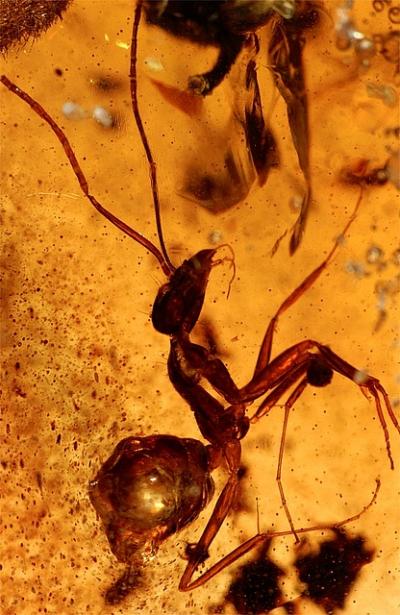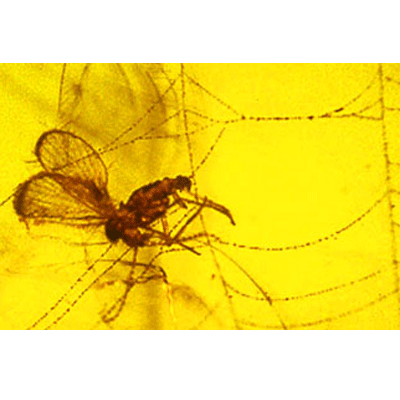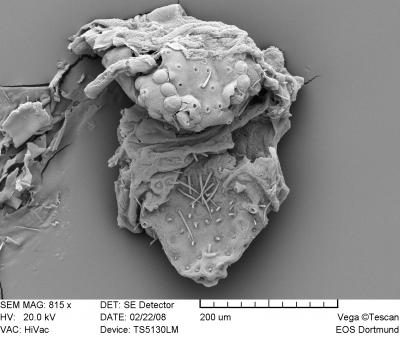Science news - Indian amber tells a tale
24-October-2010
Indian amber tells a tale
An ancient insect trapped in amber is one of the clearest windows to Earth's past that we know of. Caught and held in sticky stuff that oozed from a living tree, the perfectly preserved little lifeform looks back at us from 10, 20, even 50 million years ago.
It's an unimaginably vast span to humans, who count the hours and minutes and have trouble remembering the details of their childhood a few decades earlier.
Fifty million years ago there were no apes or humans on Earth. If you decided to count to 50 million, and each number took you two seconds, you would get there in 1157 days. That's over three years of counting around the clock.
But 50 million years is a heartbeat compared to the age of Earth itself. That formed 4,500 million years ago from rocks, dust and gas around a brand new sun. Amber is old. But the earth is far older.
Cough drops
Amber appeals to the senses and the scientists. Professor Dr. Jes Rust and palaeontology colleagues at the University of Bonn have just spent two years studying amber from the coast of north-west India's Gujarat province.
As they are dug unpolished out of the ground, pieces of amber look a bit like herbal cough drops. Those from Gujarat contained large numbers of fossil lifeforms, the scientists found. Some were very well preserved, despite having died 50 million years ago.
The petrified resin was readily persuaded to release its contents, Rust says. "The amber has not been completely polymerised, allowing it to be dissolved easily."
So far the researchers have found more than 700 arthropods from 55 different genera in the amber. Most of these are insects, but they have also extracted spiders, mites and parts of plants.
These tell us about past life on Earth – as fossils always do – but they do more than that. There is also a larger story in these stones.
Violent collision
Plate tectonics is the accepted theory of how the surface of the Earth changes, as the continents drift around over long periods of time. In this picture India was believed to have broken off from East Africa around 160 million years ago, to float through the oceans on its own.
Its speed of drift was estimated at 20 centimetres a year. This is fast compared to the usual speed of continental drift of 1-2 centimetres a year – the same speed as your fingernails grow.
India then collided with Asia 50 million years ago. The crash was so violent that it caused the land to crumple, forming the tallest mountains on Earth, the Himalaya.
In this scenario India was isolated for over 100 million years. That should have been enough time for unique flora and fauna to evolve there. But did they?
The Indian amber Rust and his colleagues have been studying formed 53 million years ago. So that was just before India smacked into Asia. That means the amber arthropods give us a snapshot of life there just before India became connected again.
Island isolation
If they had been evolving in isolation for 100 million years there should be animal species in the amber that don't exist anywhere else on Earth. But there aren't.
The palaeontologists have been finding insect fossils in the Gujarat amber similar to those already found in Europe and even Central America. "This indicates that there was a lively exchange of species before our amber formed," Rust says.
So India was out in the ocean, but it was not isolated from other lands as far as life was concerned. There must have been plenty of mixing between species on India and elsewhere in the world.
One possibility is that there were long chains of volcanic islands between the continents, Rust suggests – as there are in Japan or Indonesia today. The insect species in India and Asia could then have mingled by "island-hopping" million of years before the big crash.
Surprise
The Gujarat amber has thrown up other interesting scientific questions. Plants and animals stuck in tree resin usually decay over time. But not in these specimens, says Rust. "In our amber, some resin component seems to have preserved the insects."
In addition, the resin that formed the amber is from a tree family known as Dipterocarpaceae. These are mainly tropical lowland rainforest trees. Their main range nowadays is in the Indo-Malayan region.
Until now scientists thought that this type of plant had its heyday 25 million years ago, Rust says. "The Indian amber proves that extensive tropical forests of Dipterocarpaceae must already have existed there more than 50 million years ago.
"That is a big surprise."
Prof. Dr. Jes Rust studied geology, palaeontology and zoology at Göttingen and Kiel. His thesis was on the evolution of fossil snails living in the waters of prehistoric Greece. In 2001 he was appointed professor of invertebrate palaeontology and insect phylogeny at the University of Bonn.
.More help with words
artificial breed crust evolution fertile fossil mantle molecule process resin species theory For other websites and resources relevant to this science story try the




